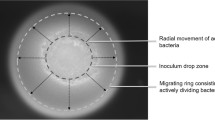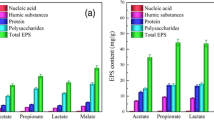Abstract
The aim of this study was to evaluate the biological toxicity of cellulose nanocrystals (CNCs) using the constitutively bioluminescent luxCDABE-based bioreporter Escherichia coli 652T7. The effects of CNCs on E. c oli 652T7 biotoxicity were investigated at different CNC concentrations, reaction times, and IC50 values. CNC toxicity was also compared with and without ultrasonic dispersion to establish dispersibility effects. The results demonstrated that CNCs were not significantly toxic at concentrations at or below 250 mg/L. At concentrations higher than 300 mg/L, toxicity increased linearly as CNC concentrations increased up to 2000 mg/L. IC50 calculations demonstrated an increase in cytotoxicity as CNC exposure times increased, and elevated dispersibility of the CNCs were shown to increase cytotoxicity effects. These results suggest that CNCs can impact microbial populations if elevated concentration thresholds are met.



Similar content being viewed by others
References
Bondeson D, Mathew A, Oksman K (2006) Optimization of the isolation of nanocrystals from microcrystalline cellulose by acid hydrolysis. Cellulose 13:171–180
Cundy AB, Hopkinson L, Whitby RLD (2008) Use of iron-based technologies in contaminated land and groundwater remediation: a review. Sci Total Environ 400:42–51
Donaldson K, Poland CA (2013) Nanotoxicity: challenging the myth of nano-specific toxicity. Curr Opin Biotechnol 24:724–734
Espino-Perez E, Domenek S, Belgacem N, Sillard C, Bras J (2014) Green process for chemical functionalization of nanocellulose with carboxylic acids. Biomacromolecules 15:4551–4560
Faedmaleki F, Shirazi FH, Salarian A-A, Ashtiani HA, Rastegar H (2014) Toxicity effect of silver nanoparticles on mice liver primary cell culture and HepG(2) cell line. Iran J Pharm Res 13:235–242
Gerber C, Lang HP (2006) How the doors to the nanoworld were opened. Nat Nanotechnol 1:3–5
Jia H, Wang Z, Wang C, Chang L, Li Z (2014a) Real-time fluorescence detection of Hg2+ ions with high sensitivity by exponentially isothermal oligonucleotide amplification. RSC Adv 4:9439–9444
Jia K, Marks RS, Ionescu RE (2014b) Influence of carbon-based nanomaterials on lux-bioreporter Escherichia coli. Talanta 126:208–213
Kang JL, Moon C, Lee HS, Lee HW, Park E-M, Kim HS, Castranova V (2008) Comparison of the biological activity between ultrafine and fine titanium dioxide particles in RAW 264.7 cells associated with oxidative stress. J Toxicol Environ Health Part A 71:478–485
Kasemets K, Ivask A, Dubourguier HC, Kahru A (2009) Toxicity of nanoparticles of ZnO, CuO and TiO2 to yeast Saccharomyces cerevisiae. Toxicol Vitro 23:1116–1122
Lee JH, Lee J-Y, Yang SH, Lee E-J, Kim H-W (2014) Carbon nanotube-collagen three-dimensional culture of mesenchymal stem cells promotes expression of neural phenotypes and secretion of neurotrophic factors. Acta Biomater 10:4425–4436
Mahmoud KA, Mena JA, Male KB, Hrapovic S, Kamen A, Luong JHT (2010) Effect of surface charge on the cellular uptake and cytotoxicity of fluorescent labeled cellulose nanocrystals. ACS Appl Mater Int 2:2924–2932
Nel A, Xia T, Madler L, Li N (2006) Toxic potential of materials at the nanolevel. Science 311:622–627
Ripp S (2011) Nanotoxicology in the microbial world. In: Ripp S, Henry TB (eds) Biotechnology and nanotechnology risk assessment: minding and managing the potential threats around us. American Chemical Society, Washington, pp 121–140
Roslev P, Lentz T, Hesselsoe M (2015) Microbial toxicity of methyl tert-butyl ether (MTBE) determined with fluorescent and luminescent bioassays. Chemosphere 120:284–291
Shi W, Menn FM, Xu T, Zhuang ZT, Beasley C, Ripp S, Zhuang J, Layton AC, Sayler GS (2014) C60 reduces the bioavailability of mercury in aqueous solutions. Chemosphere 95:324–328
Xu T, Close DM, Sayler GS, Ripp S (2013) Genetically modified whole-cell bioreporters for environmental assessment. Ecol Indic 28:125–141
Yu H, Yan C, Lei X, Qin Z, Yao J (2014) Novel approach to extract thermally stable cellulose nanospheres with high yield. Mater Lett 131:12–15
Acknowledgments
This research was partially supported by the National Natural Science Foundation of China (Project No. 31171977), the Doctoral Fund of Ministry of Education (Project No. 20112103110003), and the Strategic Priority Research Program of the Chinese Academy of Sciences (Grant No. XDB14020204). The University of Tennessee’s Center for Environmental Biotechnology also provided financial support for the experiments.
Author information
Authors and Affiliations
Corresponding author
Ethics declarations
Conflict of Interest
The authors declare that they have no conflict of interest.
Rights and permissions
About this article
Cite this article
Du, L., Arnholt, K., Ripp, S. et al. Biological toxicity of cellulose nanocrystals (CNCs) against the luxCDABE-based bioluminescent bioreporter Escherichia coli 652T7. Ecotoxicology 24, 2049–2053 (2015). https://doi.org/10.1007/s10646-015-1555-0
Accepted:
Published:
Issue Date:
DOI: https://doi.org/10.1007/s10646-015-1555-0




